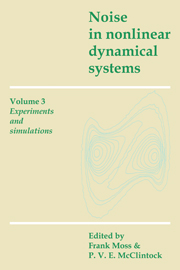Book contents
- Frontmatter
- Contents
- List of contributors
- Preface
- Introduction to Volume 3
- 1 The effects of colored quadratic noise on a turbulent transition in liquid He II
- 2 Electrohydrodynamic instability of nematic liquid crystals: growth process and influence of noise
- 3 Suppression of electrohydrodynamic instabilities by external noise
- 4 Colored noise in dye laser fluctuations
- 5 Noisy dynamics in optically bistable systems
- 6 Use of an electronic model as a guideline in experiments on transient optical bistability
- 7 Computer experiments in non-linear stochastic physics
- 8 Analogue simulations of stochastic processes by means of minimum component electronic devices
- 9 Analogue techniques for the study of problems in stochastic nonlinear dynamics
- Index
4 - Colored noise in dye laser fluctuations
Published online by Cambridge University Press: 05 January 2012
- Frontmatter
- Contents
- List of contributors
- Preface
- Introduction to Volume 3
- 1 The effects of colored quadratic noise on a turbulent transition in liquid He II
- 2 Electrohydrodynamic instability of nematic liquid crystals: growth process and influence of noise
- 3 Suppression of electrohydrodynamic instabilities by external noise
- 4 Colored noise in dye laser fluctuations
- 5 Noisy dynamics in optically bistable systems
- 6 Use of an electronic model as a guideline in experiments on transient optical bistability
- 7 Computer experiments in non-linear stochastic physics
- 8 Analogue simulations of stochastic processes by means of minimum component electronic devices
- 9 Analogue techniques for the study of problems in stochastic nonlinear dynamics
- Index
Summary
Introduction
The investigation of the coherence properties of light sources has traditionally involved the study of correlation functions of different orders of the electric field (Born and Wolf, 1975; Mandel and Wolf, 1965). Field and intensity correlation functions have been measured for laser light (for a review, see Lax and Zwanziger, 1973) and have been compared with predictions obtained from quantum laser theory (Haken, 1970, 1981; Lax, 1969; Louisell, 1973; Sargent, Scully and Lamb, 1974). This was, in fact, one of the major confirmations of the correctness of the basic formalism of quantum laser theory. Most of the experiments that probed the coherence properties of lasers were, however, carried out on a very limited variety of lasing media. Interest was also centered on the regime of operation near threshold, where the light from the laser is extremely weak; hence photoelectron counting and correlation techniques were developed for the measurement of coherence properties of the laser light.
While these early experiments were performed with the main intent of testing the basic theory, the large variety of lasers now available, and their ever more demanding applications, make it necessary to develop new methods for the measurement and analysis of laser fluctuations. These techniques should be applicable to the measurement of noise in high power lasers; at the same time, in order to delineate the limits of usage, they must be sensitive enough to quantitatively determine the quantum mechanical sources of noise which may lie buried in external noise that is many orders of magnitude larger.
- Type
- Chapter
- Information
- Noise in Nonlinear Dynamical Systems , pp. 90 - 118Publisher: Cambridge University PressPrint publication year: 1989
- 4
- Cited by

